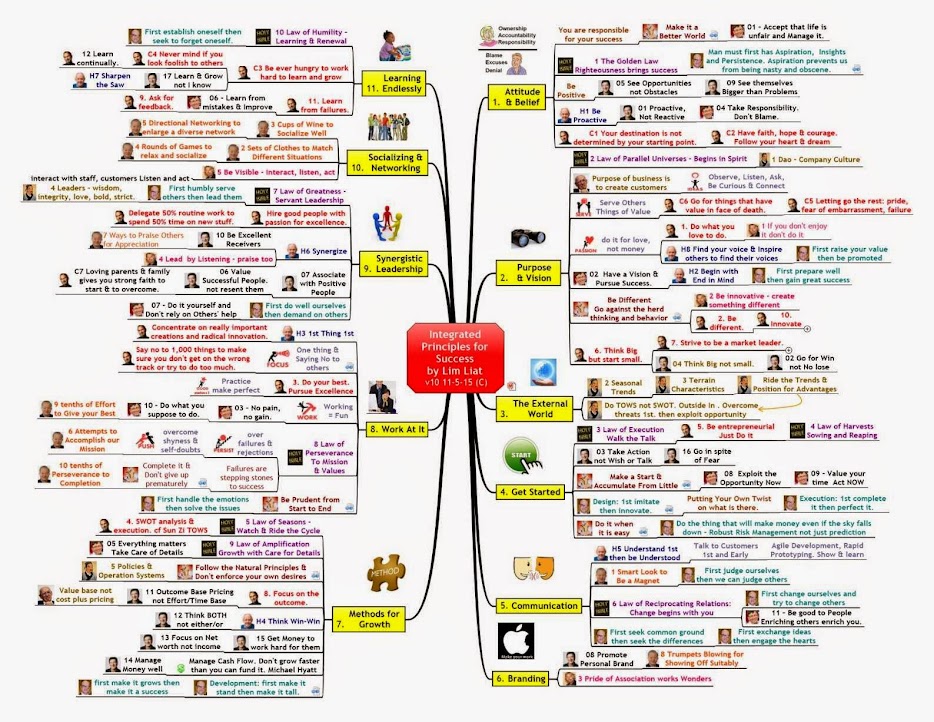The Art of War Winners' mindset helps us to understand the rise and fall of nations and also of corporations. It can be the guide for us to build successful businesses. Here is a series of stories of the Smart-phone wars that explained the successes of Apple and Androids and the failures of Nokia-Microsoft phones.
The Sun Zi's Art of War that even the experts may not know #3:
We have to go back to the very basics of Sun Zi's Art of War - the Five Factors and Seven Measures.
The five factors are Philosophy, Seasonal Timing, Terrain Advantages, Leadership, Policies & Processes, and a sixth-factor Customers Desires added by me for business use.
The philosophy of business is best captured in the Mission, Visions, and Values of the business that when really practiced by the top and the bottom will become the culture of the company.
See Who has the Best Mission statement?
The Right Way to Do SWOT - TOWS
We will use a well-known method for the design of strategies called SWOT.
But we will follow Sun Zi's teaching and do it in the right order of TOWS.
The first principle from Sun Zi is outside-in analysis. Our perspective should start from the external environment, the external factors, the threats and opportunities, and then looking for the relevant internal factors of our comparative weaknesses and strengths.
The second principle is risk averse, risk first analysis. Hence we must overcome the threats first before we can talk about the opportunities. If we are unable to address the threats, all the opportunities are false optimism.
These TOWS order guards against the typical optimism of project proposers and sponsors who tend to underestimate the risks and over-rate the potential opportunities.
So our Sun Zi based Outside-In, Threats before Opportunities, TOWS analysis should look like this:
Objective:
|
Start with External Factors of Season Timing, Terrain Advantages, and Customers Desires:
|
Threats
|
Opportunities
|
1.
|
1.
|
The Internal Factors of Philosophy, Leadership, Policies & Processes, Staff:
|
Weakness
|
Strengths
|
1.
|
1.
|
The Strategic Initiatives:
|
1.
2.
Lim Liat copyrighted 25 May 2015
|
Seasonal Trends & Timing for Business includes the PESTEL factors of Political, Economic, Social, Technological, Environmental, and Legal.
Terrains for business relates to the markets and market positioning. In the markets are various competitors and supply chain partners and competitors.
The winning principle is to choose the market where your abilities become strengths and your competitors' become irrelevant or weaknesses in the eyes of your target customers.
Every analysis of the TOWS must derive the strategic initiatives that need to take such that:
1. Our weaknesses exposed by the threats are handled and eliminated, or even better converted to strengths to overcome the threats to become opportunities to be exploited.
2. Our strengths exposed by the threats can be gainfully employed to overcome the threats.
3. In the same way, our weaknesses that may prevent us from exploiting the opportunities are eliminated or converted to become strengths to take advantage of the opportunities.
4. Our strengths relevant to the opportunities can be recognized and profitably employed.
We shall use the Google Android experience rather than the earlier mentioned Microsoft successes which may be too old for many younger readers to know.
The Apple iPhone was announced by Steve Jobs in Jan 2007. The first Android phone was HTC dream announced in Sep 2008. So we can roughly say that Android is about 1.5 to almost 2 years behind the iPhone. They have much to catch up then.
So here is the TOWS analysis may be done by Google in 2005-6? (Note: This is my fictitious thinking for illustration of TOWS and were not real).
The weaknesses revealed in the analysis of threats caused Google to use its existing strengths to acquire the skills and to pull in many other leaders in hardware and telecoms to form the OHA to create new strengths to snatch the opportunities from Apple. Android soon became the market shares leader and many of its partners, namely Samsung and HTC earlier and China Huawei, Lenovo, ZTE and lately XiaoMi to become major players in the smart-phone cloud-device market. While they may not be as profitable as Apple and are still successful.
Lim Liat (c) 25 May 2015
======
Update 7 Aug 2019
The Sun Zi of Finance in Action - Holding a lot of cash because there is no good opportunity.
See how the wise apply it in real life.
For an investor, sitting on idle cash is costly.
He has to pay his clients interests but the idle cash is not generating any interest at all.
Yet if you really understand Sun Zi's Outside-In and Threats before Opportunity approach, then you understand Warren Buffett's action. When there is no good opportunity, or if the market is going down, if you invest at all, you at just investing in bad deals (no matter what the optimistic forecasts are. That's the job of the people asking you for investments) and will lose more instead.
So, if the market, the external world, does not provide you any good opportunity, keep your cash. You cannot force it out of the external world. You just have to adapt to it. So wait and see is a good policy to follow.
https://www.inc.com/jason-aten/warren-buffett-has-a-122-billion-problem-it-could-be-really-bad-news-or-a-really-good-lesson.htmlSee:





